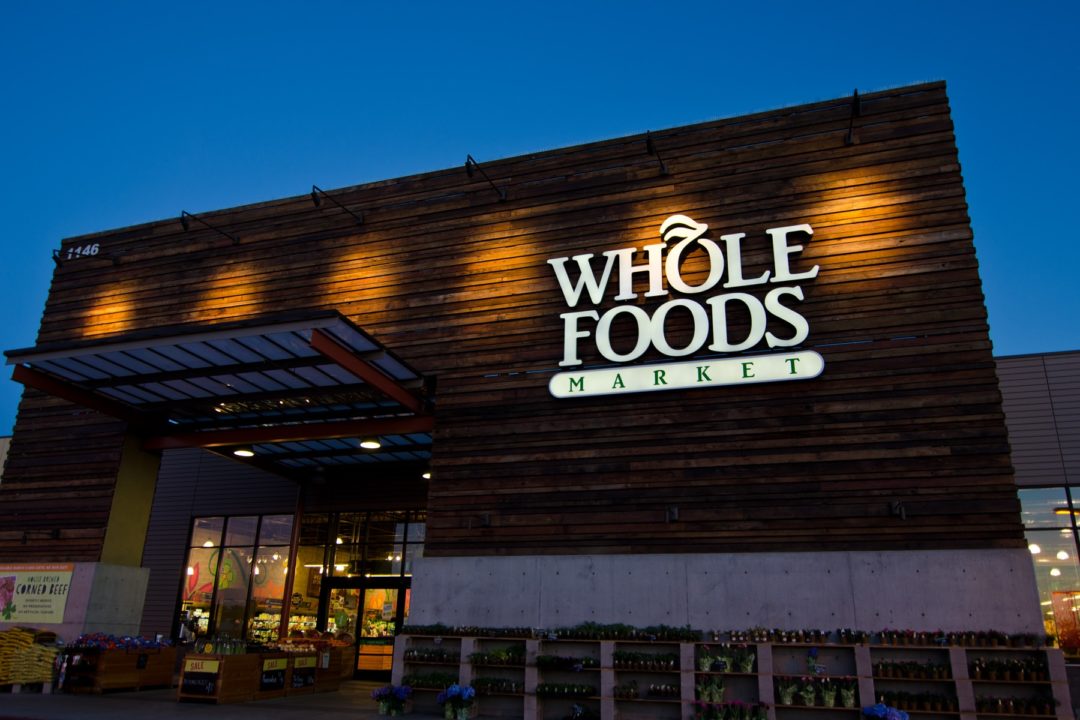
Amazon-Whole Foods Two Years In

Grocery Shopping for EveryoneIn early 2017, an internal Amazon memo entitled “Grocery Shopping for Everyone,” written in press-release style—as is the company’s process when envisioning a new business idea—described a new type of grocery chain. The stores would feature fresh perishable foods, including produce and prepared meals, available to the public on the retail floor. But non-perishable, shelf-stable packaged foods and other staple non-foods would not be. Instead these items would be warehoused on a separate but adjoining non-retail floor, available only by ordering through an app.
While shoppers make their way through the fresh foods retail area, the memo stated, employees next door would be selecting their non-perishable items, meeting up and delivering these items to shoppers as they check out. There would also be a separate area dedicated to delivering items ordered online and to coordinating packages for delivery drivers. The memo went on to note the rapid consumer shift from offline grocery shopping to mixed-format shopping.
But all Amazon internal efforts to develop this new grocery concept soon came to a halt.
Opportunity KnocksIf you recall, around April, 2017, Whole Foods’ CEO, John Mackey, reached out to Amazon CEO Jeff Bezos to see if he was interested in buying Whole Foods. At the time, activist investors Jana Partners and Neuberger Berman were pressing Whole Foods to change strategy. The company had reported negative same-store sales for the prior two years, and new full-size store expansion was on hold. Its recently launched, streamlined, no-frills small-scale stores dedicated to its 365 Everyday Value private label line were delivering mixed results.
Imagine yourself in Bezos’s shoes. Richest man in the world. Owner of a publicly traded company with a then-$300-billion market capitalization (2017). Plans for his lunar landing company, Blue Origin, to facilitate colonizing the moon. Four years earlier, he had personally acquired the strugglingWashington Postnewspaper, at a steep discount.
You can sense that John Mackey walking through his door would align perfectly with Bezos’s outsize ambitions. Strategy? Who needs strategy when the $13.4 billion cost to buy Whole Foods is essentially a rounding error on Amazon’s books?
Mixed ResultsAs we asked at the time, does Amazon care what it sells, and, does Whole Foods Markets care what it sells? “The opposing answers to these two questions—‘No’ and ‘Yes’ respectively—are at the heart of the problem Amazon CEO, Jeff Bezos, now hopes to solve. Put another way, can Bezos make fresh, organic, free-range filet mignon behave like J.R.R. Tolkien’s latest novel,Beren and Lúthien, on an Amazon Prime delivery truck?”
In trying to overcome the obvious cultural differences between Amazon and Whole Foods—Mackey wrote a best-selling book on how companies should have a social conscience; Amazon corporate principles say good leaders “do not compromise for the sake of social cohesion”—Amazon started by lowering Whole Foods prices to combat its “Whole Paycheck” reputation.
But the company ran into trouble trying to apply everyday discounts to premium fresh groceries. As theTimesreports, a major produce supplier to Whole Foods had to explain to Amazon managers that, while the store could offer seasonal fresh berries and lettuce year-round because of global supply chains, off-season, these items would cost much more to get to the store. Amazon executives apparently hadn’t thought deeply enough about the difference between selling perishables and selling books.
Amazon doesn’t break out its retail store sales individually, instead grouping its several retail banners together, including about 500 Whole Foods Markets, a dozen Amazon Go stores, 18 Amazon Books, several Amazon 4-Star, and several dozen Amazon Pop-Up stores inside Kohls and other locations. What we can surmise is that sales have grown at Whole Foods Markets, but primarily through delivery and online ordering, not within physical stores.
Back to the Drawing BoardThe original internal Amazon memo envisioned more than 2,000 U.S. hybrid grocery stores, with retail areas for customers to examine and pick their own fresh items, and attached warehouses for employees to select non-perishables ordered through an app, marrying the two baskets at checkout. Recently, Amazon has been looking for grocery store space separate from Whole Foods, apparently revisiting this idea.
It makes sense. The Whole Foods tail is not going to be able to wag the Amazon dog. Amazon must revert to its original business model: uniform, universally scalable goods delivered as rapidly and cheaply as possible.
According to theWall Street Journal,since last fall, Amazon has told companies they must make packaging for larger products more compact and easier to open, or face fines. Also, brands must sell products in quantities, and at prices that best fit Amazon’s storage and delivery systems. Brands that don’t comply are pulled from the website.
Two years post the Amazon-Whole Foods deal, the shopping experience and consumer preferences are also evolving. Some examples:
1. Never Leave Home Again?With so much new investment going into figuring out how to deliver all goods to consumers’ homes, you may fear the world of brick-and-mortar is coming to an end. Not necessarily. While delivery and click-and-pick-up are rapidly growing, the vast majority of shopping still takes place in a physical store.
And, not everyone will embrace deliveries. Have you ever wondered about the security of a freshly prepared meal being delivered to your doorstep? Well, perhaps you should. A report by Restaurant Business cites a new study by wholesale food distributor U.S. Foods that found 21% of delivery customers worry the driver may have nibbled their order en route. They may be too trusting. According to the study, 28% of drivers say they were unable to resist taking a bite.
Late deliveries and incorrect orders are also fairly common. To be fair, orders placed in restaurants to eat there are wrong 14% of the time. The difference is, you can correct the problem when you are in a restaurant because you are there. About 85% of customers who order food delivered would like restaurants to adopt tamper-proof packaging.
Profit margins for restaurants on delivered orders are much smaller because of the cost of delivery. Adding an expensive new packaging will only increase pressure on profits. Delivery drivers have their complaints, too. About 60% say customers don’t tip, or tip too little, and over half say restaurant orders aren’t ready on time.
2. The Next Generation of Internet Commerce: Physical StoresIt is getting very expensive to find new customers by advertising online. So much so that some internet-first companies are finding it cheaper to pay retailers to put their products on the shelf in physical stores.
The new model that is emerging envisions a store that is a marketplace for multiple brands, each of which simply pays to rent the retail space. Retail tenants no longer need to worry about owning inventory, as they will be able to pay their leases by collecting rents from the brands. Brands in turn keep all that they make from selling the goods.
The company behind the new model is b8ta, as reported by theWall Street Journal, which has helped Toys ‘R’ Us make its comeback, and is supporting the software at the back end of Macy’s experiment, Market@Macy’s.
3. Gen Z: Hungry for Human TouchGen Z, the generation born between 1997 and 2012, the oldest of whom is now 22, prefers shopping in physical stores vs. online, according to a report by thePhiladelphia Inquirer.The reports states that 55% of Gen Z women and 40% of Gen Z men prefer shopping in bricks-and-mortar settings, and two out of three do so for fun at least once a month.
These teens are also gravitating towards an app, Huji Cam, which makes photos look weathered and grainy, as if shot by a disposable camera. Why? To make their photos look less staged and more authentic, according to a report inRestaurant Hospitality.
4. An Analog Renaissance?Christmas cards haven’t gone out of style either, selling 6.5 billion per year, according to the Chicago Tribune, which suggests people need to feel a tactile connection to others. Paper coupons and printed catalogs—think Trader Joe’s Fearless Flyer—still come in the mail.
With the internet becoming more crowded and expensive, retailers have been taking advantage of direct mail, an affordable way to reach shoppers with greatly increased chances of being noticed and read.
And guess what? TV is still the greatest influence on purchasing behavior, with 56% of consumers saying TV is their main source of information for goods and services, according toSpecialty Food News.
As an independent natural products retailer, you are probably steering in the right direction to hire people able to put their egos and personal problems aside when face to face with customers, and who care enough about them to help them achieve their goals. The need for human connection is not going away. Be that place.JJ

Jay Jacobowitz is president and founder of Retail Insights®, a professional consulting service for natural products retailers established in 1998, and creator of Natural Insights for Well Being®, a comprehensive consumer marketing service designed especially for independent natural products retailers. With over 40 years of wholesale and retail industry experience, Jay has assisted in developing over 1,000 successful natural products retail stores in the U.S. and abroad. Jay is a popular author, educator, and speaker, and is the merchandising editor of WholeFoods Magazine, for which he writes Merchandising Insights and Tip of the Month. Jay also serves the Natural Products Association in several capacities. Jay can be reached at (800)328-0855 or via e-mail at jay@retailinsights.com.
The Magazine
Information
About Us
NOTE: WholeFoods Magazine is a business-to-business publication. Information on this site should not be considered medical advice or a way to diagnose or treat any disease or illness. Always seek the advice of a medical professional before making lifestyle changes, including taking a dietary supplement. The opinions expressed by contributors and experts quoted in articles are not necessarily those of the publisher or editors of WholeFoods.







